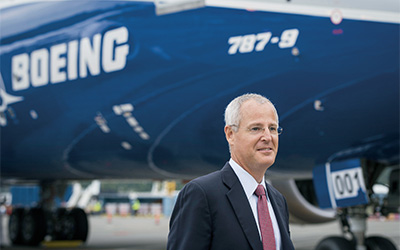
“I actually started at Rensselaer on an NROTC scholarship, hoping to become a pilot on my way to entering the astronaut program,” Jenks recalled. “Unfortunately, my eyesight didn’t cooperate. Even if I couldn’t fly into space, though, I was still determined to make a career working on large-scale aerospace projects.”
Consider his mission accomplished. Since 1983, Jenks has contributed his skills to nearly every type of product and component developed by Boeing, from helicopter rotors and wing design to the International Space Station. In the process, he helped turn around one of the aerospace giant’s most challenging projects.
From Helicopters to Outer Space
Jenks began his Boeing tenure in Philadelphia analyzing the computational fluid dynamics behind advanced helicopter rotors. After earning master’s degrees in materials engineering and management, he took over Boeing’s Helicopters Division Developmental Center, overseeing all phases of manufacturing the RAH-66 Comanche and the structural testing of the V-22 Osprey.
Then came one of the highlights of his career: five years working on Boeing’s contribution to the International Space Station (ISS).
“My time on ISS has got to rank right up there with my most challenging and, at the same time, most rewarding assignments,” Jenks said. “I had the opportunity to work closely with the astronauts, learn about the technical details of Shuttle operations, be at the Cape to see my hardware launched, and sit in mission control in Houston as it was first put into operation in orbit. For an aerospace engineer who grew up watching the Apollo missions, it just doesn’t get much better than that.”
While on the ISS project, Jenks took on a variety of responsibilities, from managing the joint U.S./ Russian airlock program to leading the engineering effort for U.S. pressurized elements. His performance must have impressed Boeing leaders, for after five years they assigned him to a position of even higher responsibility: technology integration director for the next generation of Boeing’s vaunted aircraft.
Taking On a Breakthrough Boeing’s 787 Dreamliner family of airplanes broke ground in several ways. It features the first-ever airframe made primarily of composites, which delivers several major advantages over traditional aluminum: lighter weight, superior corrosion resistance, very good fatigue performance, and flexibility in wing design. The use of electronics to control the aircraft’s systems— deicing, braking, and cabin pressurization, among others—is more extensive than ever before.
Jenks oversaw the selection of these technologies as part of his leadership position. Later, he led the design team for the Dreamliner’s wing and eventually took over as vice president of engineering for the whole effort.
After its launch in 2004, the Dreamliner became the fastest selling twinaisle commercial aircraft in Boeing history. However, its development also ran into well-documented technical problems. “As with any major aerospace project that pushes the boundaries of technology, the 787 development process encountered some significant, and often very public, challenges,” Jenks said. “With challenges come intense learnings, and that was certainly the case for me.”
As it turned out, Jenks was soon able to put those intense learnings to good use. “I was given the truly unique opportunity to apply all those lessons learned as the program manager for the first derivative of the Dreamliner, the 20-foot stretch called the 787-9.” Jenks’s team certified and delivered the 787-9 ahead of schedule, with major improvements in capability, reliability, and producibility. His work on the project continues to this day: he currently serves Boeing as vice president of 787-9 development.
Spanning the Globe
The Dreamliner’s unique development model—using teams and plants around the world to design and build individual components— turned Jenks into a world traveler: his responsibilities took him to Melbourne, Moscow, Naples, Japan, China, Sweden, and numerous other locales. When suppliers from these far-flung regions came to Boeing’s headquarters in Everett, Washington, “it was like the United Nations of aerospace design,” Jenks remembered. “You could walk down the hall and hear four languages.”
The project’s international nature fit well with one of Jenks’s passions outside of work: adventure travel. In the last few years alone, he and his wife have traveled on safari in the Serengeti, climbed an island volcano in Lake Nicaragua, and explored jungles in Cambodia and Central America.
“There aren’t many engineering endeavors that truly harness the unique and diverse capabilities of the world’s technology leaders, and the 787 is perhaps the most prominent example,” Jenks said. “I’d have to say that it’s been the highlight of my career and a real privilege to play a part in that amazing process.”
The Rensselaer Connection
Jenks credits many aspects of his experience at Rensselaer— where he earned his bachelor’s and master’s degrees in aerospace engineering—for his current success. “Clearly, the technical foundation that I received has served me well, and I’ve always felt technically prepared to deal with any new engineering challenge,” he said. “I also played football for Rensselaer and was a member of TKE fraternity, experiences that taught me a lot about being a part of an effective team.”
Today he serves on MANE’s Strategic Advisory Council—and his work there has given him insight into engineering education. “Rensselaer has always been known for the practical abilities of its graduates, and that’s a real attraction for those of us in industry,” Jenks said. “At its heart, engineering is about solving problems and developing solutions that can positively impact the lives and opportunities of people around the world. It’s that perspective that we need to continue to bring to the education of the next generation of Rensselaer engineers.”




